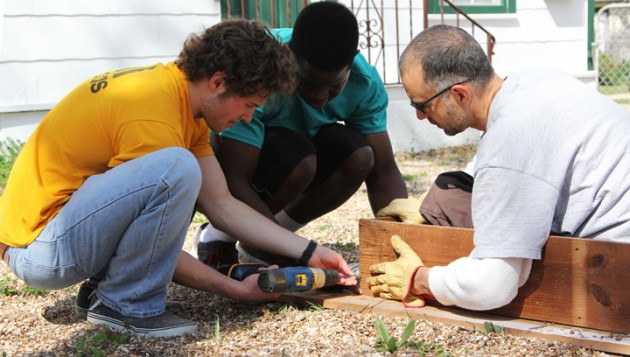

David Li | Lariat Photographer
By Linda Wilkins
Staff Writer
Two Baylor students will have the opportunity to interact with the Waco community on a daily basis, possibly beginning in the fall.
Weeding, painting, gardening and cleaning outside the 2301 Colcord Ave. house, where the two students will live, was the focus of volunteer work by Baylor service organizations Saturday in association with the Good Neighbor Settlement House-Waco.
Dr. Laine Scales, Baylor professor of higher education, said the house is in the process of becoming a modern-day settlement house, modeled after the 19th century settlement house movement.
Scales said the settlement house experience has potential to be incorporated into Baylor classes such as the Baylor Interdisciplinary Core, social work, education, business, and any relevant subject. She said university students in the 18th century established a gathering place for people in their neighborhoods to come and fellowship together. This idea of community, she said, is a part of social work history.
Scales told the volunteers people in modern-day neighborhoods stay disconnected from their neighbors because of economic, social and racial differences. In the Sanger Heights neighborhood, where the house is located, the residential make-up is 50 percent Latino, 25 percent African-American and 25 percent Caucasian, Scales said.
The settlement house is a way to break the various types of barriers in the neighborhood, she said.
Scales said she bought the foreclosed house from the bank in February 2011 with a vision of revitalizing the historical movement of settlement houses.
“We are bringing to life our roots of the social work profession,” Scales said.
Unable to work inside the house yet because of the severe state of disrepair, the volunteers focused their attention on the outside of the house Saturday afternoon. Scales said Good Neighbor Settlement House needs skilled labor volunteers such as plumbers, electricians, architects and structural engineers and more funds to repair the house.
Once this work is done and the city of Waco declares the house occupiable, work can begin inside the house to make it a place for the community.
Once the house is repaired, Scales said ideally two graduate students would move into the upstairs apartment and help orchestrate the community involvement with the house.
Students interested in living in the house can go to www.goodneighborwaco.com. They can express their interest by sending an email to graduate student Morgan Caruthers, who is the president of the Good Neighbor board. Applicants will be interviewed by the Good Neighbor board. The living arrangements would be for the fall. if work on the house is finished in time.
Once the house is open, Baylor-coordinated programming by the live-in students would be kept to a minimum to give the neighborhood a chance to establish its own interests, such as book clubs, cooking demonstrations, gardening and other activities, Scales said.
This would promote a closer community, she said.
In addition, she said her greater vision for the neighborhood would be to have other students move into houses in the neighborhood to increase student participation in the community.
Dr. Tanya Brice, professor of social work, said all of these activities are what the historical settlers, or people in the settlement house community, participated in.
Brice said the house was originally a daycare that operated for about 60 years.
“Not only is the house going to be a part of the tradition of settlement houses, but it also has a history of its own,” Brice said.
Brice also said having university students involved is “an important key of staying close to the methodology of settlement houses.”
Brice and Scales agreed student volunteers and student involvement is essential to bringing the settlement house to life.
Houston sophomore Lanre Aboderin, a member of the BIC program, volunteered at the house Saturday and on Martin Luther King Service Day on Jan. 17.
“It [the settlement house] is a really great vision if it all comes together,” he said. “Any place where people can come together and actually get to know one another, break social norms and break stereotypes is good.”
Aboderin said volunteering at the house and the idea of the settlement is a good representation of how Baylor can function as a community of neighbors capable of helping others.
El Paso sophomore Victoria Morgan agreed with Aboderin.
“People are always talking about getting outside of the Baylor Bubble and this seemed like a really great way to do it, especially because they have Baylor students living in the house,” Morgan said.
Dr. Amy Antoninka, BIC professor, said students can learn the benefits of volunteering during their experience working at the house and in the community.
“Having students here [at the house] on a recurring basis makes them recognize that neighborhoods and neighbors are crucial in their life, whether they stay in Waco or not,” Antoninka said.
Scales said the teaching opportunity of the experience extends beyond working at the house.
The settlement house experience will be incorporated into social work classes in the fall, by having students write proposals to neighborhood boards for projects like the settlement house or other community involvement ideas.
She said the proposals will show students how to gather support from the community, a process that is essential to making a settlement house successful because it is based on the combined efforts of students and neighbors.
Brice said students could see how the settlement house comes to life and what resources are involved in that process, as well as become engaged in the community.





